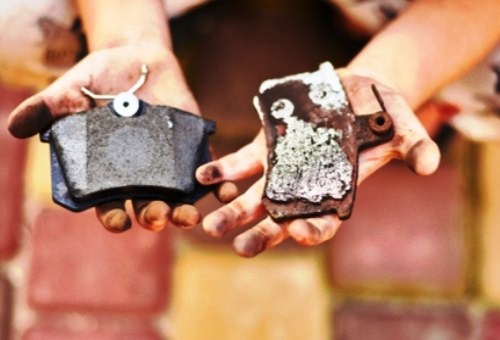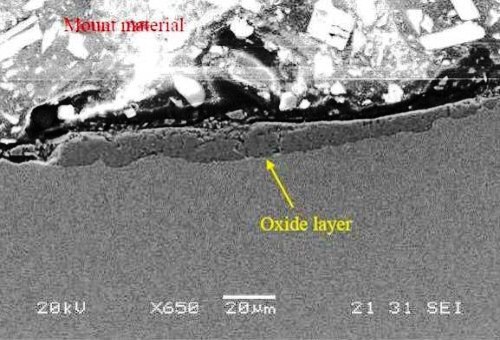
How often do you encounter brake pads on which the friction material had delaminated, or separated from the steel backing plate? More to the point though, how often have you seen this on brake pads that still have significant amounts of friction material on them? If you encounter this frequently and have to explain to customers why the brake pads on their vehicles have to be replaced prematurely or worse, yet again, do you know what to say? The issue of brake pad delamination is more common than you might think, and in this article, we will take a closer look at why and how it happens, starting with the-
While it is true that OEM manufacturers the world over spend vast amounts of money on developing brake pads that comply with ISO standard 15484:2008, which is composed of various other standards, including ISO 27667 – Brake lining friction materials – Evaluation of corrosion effects on painted backing plates and brake shoes, it is also true that these standards are only applied to brake pads fitted to new vehicles.
The fact is that there are no quality standards that apply specifically to aftermarket brake pads, and that therefore, anybody and his proverbial mate is free to manufacture brake pads for any application- without any oversight mechanisms being in place to enforce at least minimum applicable quality and safety standards.
This not to say that all aftermarket brake pads are bad; far from it, and Australian technicians and consumers have access to a wide range of high quality brake pads and other brake products that meet, and often exceed OEM specifications in terms of fit, form, and function. So where is the problem, you ask?
You may well ask, since the Australian aftermarket is not immune against the flood of cheap, substandard, and potentially dangerous brake pads that are peddled worldwide through a network of less than honest distributors. As a practical matter, you can never be quite sure that the brake pads you fit to a customer’s vehicle are not dangerous knock-offs of a reputable brand, which is aggravated by the fact that a cursory visual inspection of new brake pads is unlikely to tell you much, if anything in the way of the pads’ provenance.
In the Australian context however, it is perhaps worth noting that all reputable manufacturers and suppliers of brake pads to the aftermarket are almost certainly in compliance with two specific provisions, these being contained in the-
Vehicle Standard (Australian Design Rule 31/04 – Brake Systems for Passenger Cars) 2017,which states in Section 5.1.1.1, that-
The braking equipment shall be so designed, constructed and fitted as to enable the vehicle in normal use, despite the vibration to which it may be subjected, to comply with the provisions of this Regulation, and in 5.1.1.2. that-
In particular, the braking equipment shall be so designed, constructed and fitted as to be able to resist the corroding and ageing phenomena to which it is exposed.
One other provision concerns the ECE R90 standard, which requires that aftermarket brake pads must exhibit the same performance characteristics as those of OEM brake pads before the manufacturer can claim that his products comply with the ECE R90 standard.
In view of the above, we are not suggesting that you should never fit aftermarket brake pads. We are suggesting however that you should be aware of the issues that some aftermarket brake pads might cause, as well as the manufacturing defects in some aftermarket brake pads that could cause sudden, and possibly, catastrophic brake failure on your customers’ vehicles, which brings us to-
The term “black steel” refers to steel that has not been treated to remove the layer of black scale that forms on the surface of hot steel that cools down in the presence of oxygen. Commonly known as “mill scale”, this layer can be removed by a process of “pickling and oiling”, which involves immersing the steel in an acid bath to dissolve and remove the scale.
However, since this process is an expensive one, many manufacturers of brake pad backing plates resort to shot blasting the steels’ surface, and while this does remove some mill scale, it also has the effect of forcing some mill scale into the granular structure of the steel, from where it cannot be removed.
How deeply mill scale penetrates the surface of the steel depends on the material used to shot blast the steel, as well as the granular structure of the particular steel alloy. The point is however that when the steel blanks are shipped to the brake pad manufacturers, all the blanks contain fragments of embedded mill scale, which are simply covered by a layer of paint after the friction material is bonded to the steel backing plate. This combination of factors/conditions is the root of the problem, and here is why-
Steel corrodes
We all know that, but since the surface of the steel backing plate now contains granules of oxides of iron that are trapped between the deeper layers of steel and the overlying layer of friction material, the friction material is not evenly bonded to the steel surface.
In practice, this means that the presence of moisture, such as might be encountered in the humid climates of coastal areas, is the catalyst in a process of corrosion that starts at the point where the edges of the friction material meet the steel backing plate. The practical effect of this is that once corrosion starts, it follows the path dictated by the distribution of the mill scale particles that are embedded in the surface of the steel backing plate.
We have all seen rust on brake pads’ backing plates, but what we cannot see is corrosion as it spreads or progresses between the layer of friction material and the surface of the steel backing plate. In technical jargon this progression of the corrosion is known as “jacking”, and if it is not detected during a brake inspection, it will eventually degrade and destroy the adhesive bond between the friction material and the backing plate, and literally “jack” the friction material off the backing plate.
Below is an image of the presence of embedded mill scale and oxide of iron between the steel backing plate and the layer of friction material-

Image source: https://gbscouncil.com/wp-content/uploads/2017/02/blacksteel_full_report.pdf
This image was made with a scanning electron microscope, and at a magnification of 650 ×, the layer of mill scale/oxide of iron between the backing plate and the friction material is clearly visible, as indicated by the yellow arrow.
This particular brake pad is one of 32 that formed the basis of a scientific study that highlighted the prevalence of brake pads made with black steel in the North American market. The results were less than encouraging to say the least, but let us look at some of the findings of the Global Brake Safety Council’s (GBSC) investigation that are contained in a report titled-
The investigation was initiated by the Canadian-based Global Brake Safety Council, and consists of engineers, physicists, industrial chemists, and other professionals who are dedicated to responsible manufacturing in the automotive industry in general, and responsible manufacturing of brake system components, in particular.
The full report of their findings is available for download here, and while it is too long to discuss all of its findings here, we can look at some salient points that are of interest to mechanics, technicians, and workshop owners/managers in Australia, starting with-
Who performed the testing?
The tests involved scientific evaluations of new brake pads that cover the range of brake pad formulations that are available to the general public. All brake pads were purchased anonymously from established retail outlets, and all were labelled and prepared strictly in accordance with accepted industry standards, which included the ASTM B117 standard for corrosion testing, and the ASTM E3-11 and ASTM E407-07 standards for surface and cross sectional analysis. The actual testing was performed by NUCAP Industries Inc.’s R&D Center laboratory whose findings form part of the GBSC report, some of which include the following-
All of the tested brake pads failed critical dimensional tests
Based on the engineering and design drawings of the brake pads under investigation, the researchers found that all the brake pads under investigation failed critical dimensional tests. Some deviated from specified lengths, thicknesses, and widths straight from the box, while others deviated from specified dimensions by varying amounts during different stages of the testing procedure(s).
Others failed the flatness test, meaning that these pads are likely to develop local hotspots during bedding in, which translates into reduced braking performance. What this means for the average technician in Australia is that should he come across black steel brake pads, he would likely have to grind paint and even metal from different parts of the backing plate to make the pads fit into the calliper bracket.
All of the tested brake pads failed the corrosion test
The corrosion part of the test called for all brake pads under investigation to be subjected to a salt pray for a period of not less than 96 hours. Part of ISO standard 27667 states that the maximum amount (by area) of red rust that can accumulate on brake pads after 96 hours is 5% of the pads’ total surface area, so to check the progression of rust on the test brake pads, they were removed from the salt spray at regular, 20-hour intervals for inspection and evaluation.
The results were illuminating. For instance, all the pads showed rust accumulations that exceeded 5% after twenty hours, but what is more interesting is that all the pads being tested also showed marked deviations from specified dimensions after this period. In almost all cases, the deviations from specified dimensions increased as the corrosion test progressed, but in some cases, the deviations were erratic and unpredictable.
The group of brake pads that showed unpredictable or erratic deviations from specifications were not painted; instead, they were protected with a layer of galvanising, and while they were not dimensionally stable, the dimensional deviations they exhibited were markedly smaller than on pads that were painted, which begs this obvious question-
That is not for this writer to determine, but some recommendations included in the GBSC report include the following [paraphrased] statements-
Thus, the GBSC report does not conclude that zinc is always superior to paint in unambiguous terms, but it should be noted that most, if not all OEM brake pads are protected against rust with a layer of zinc, which may or may not be covered by paint as an additional protective layer. If we look at this objectively, it should tell us that for the most part and even though zinc is not is not 100% effective, OEM manufacturers have concluded that out of all the corrosion inhibitors that are currently available to them, zinc offers the best possible protection against corrosion on brake pads, which leaves us with this-
There is no guarantee that the next set of brake pads you install will not be made of un-pickled steel, which means that the next set of brake pads you fit might fail long before its expected expiration date.
Therefore, the Global Brake Safety Council report should be on your required reading list not only to educate yourself, but also to provide you with information you can use to dissuade your customers from insisting that you fit economy line brake pads on their mistaken assumption that brake pads are all the same. They are not.